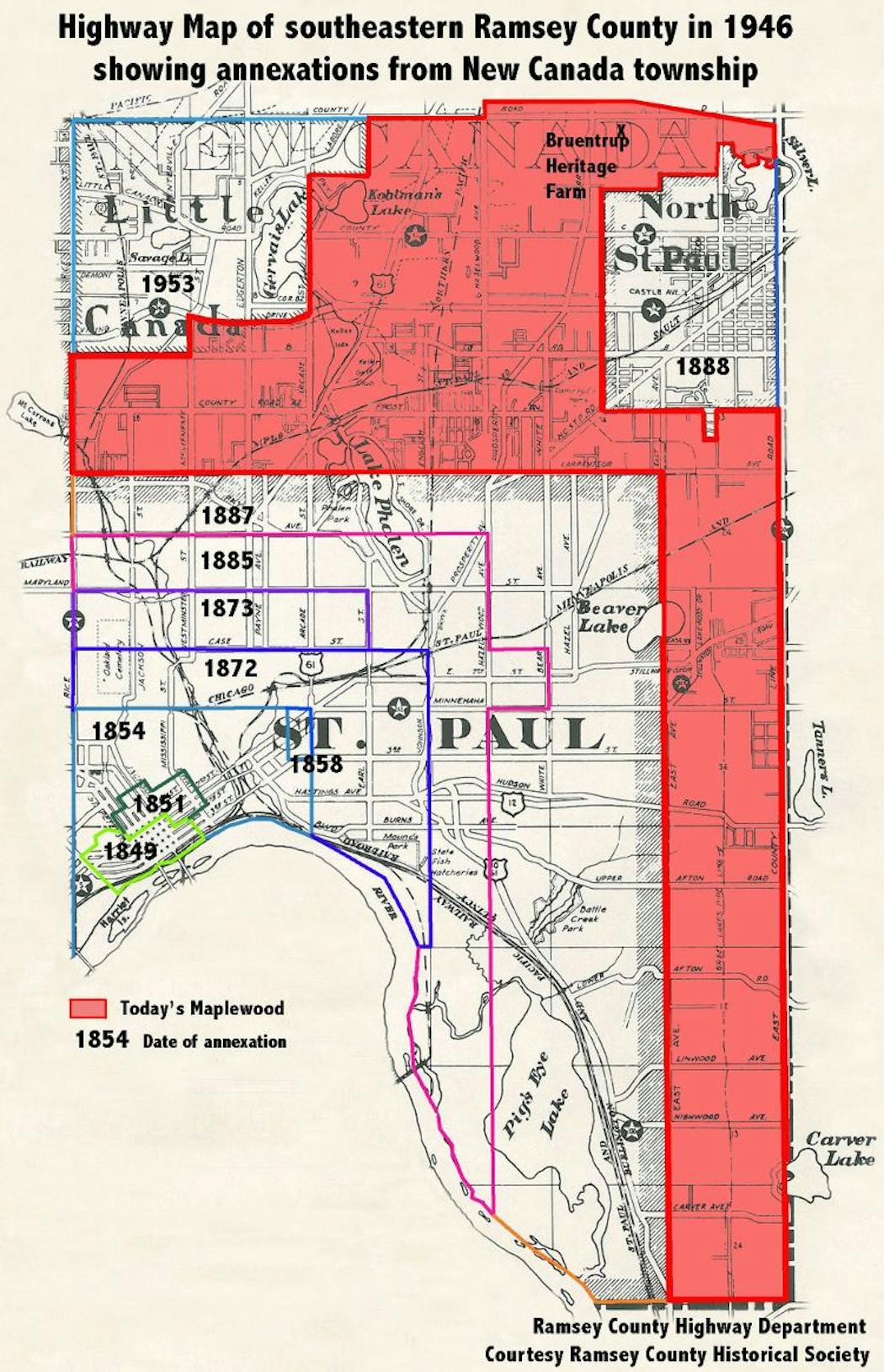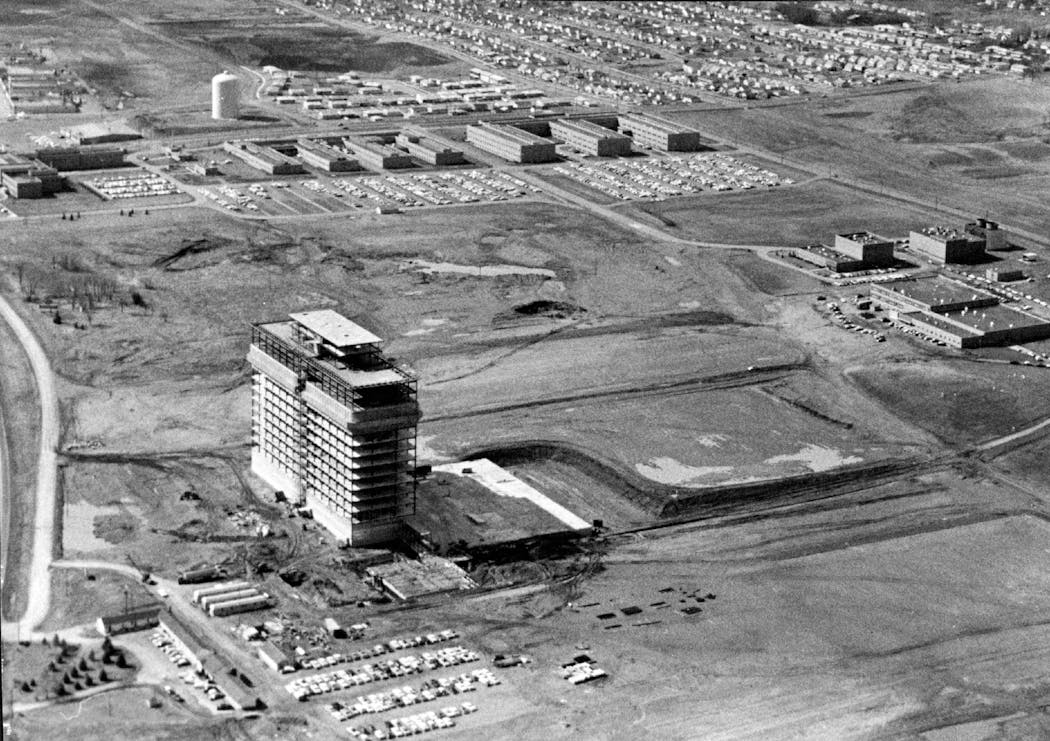Why does Maplewood have such an odd shape?
Listen and subscribe to our podcast: Apple Podcasts | Spotify
Maplewood might be the most strangely shaped city in Minnesota.
At least that is the contention of T.J. Malaskee, executive director of the Maplewood Area Historical Society.
"It is this weird kind of lump mass in the northern part of the city and then there's this weird thin leg and that goes down," he said.
Defying easy description, the boundaries of this east metro suburb of roughly 40,000 — bordering St. Paul — prompt a lot of questions. Bill Pawlyshyn is one of several readers who have written to Curious Minnesota, the Star Tribune's reader-fueled reporting project, asking how Maplewood got its peculiar shape.
"I'm just kind of a geographic geek, so I love geographic anomalies," Pawlyshyn said. The Twin Cities native who lives near Maplewood said the city's "really weird shape" has stuck out to him on maps.
"I've heard it's shaped like an L," said Maplewood Mayor Marylee Abrams. "[Or] it's shaped like a key — I don't quite get that."
Maplewood is the land that was leftover as St. Paul and suburbs in the east metro developed in the early to mid-20th Century. Its incorporation in the 1950s ensured that 3M's new headquarters would belong to Maplewood, not St. Paul.
The townships evolve
The Star Tribune visited the "lump mass" portion of Maplewood to learn the story at the Maplewood Area Historical Society, located on the historic Bruentrup farm.
This area and the rest of the Twin Cities was the home of the Dakota people prior to white settlement in the early 1800s.
The federal government first surveyed the Maplewood area in the late 1840s, creating six-mile square unincorporated townships, according to a history by former Historical Society president Bob Jensen. When Minnesota became a state in 1858, the two townships that make up modern Maplewood were named New Canada and McLean.
It wasn't too long after these townships were formed that neighboring cities and villages began taking bites out of them.
The main aggressor was St. Paul, which through the 1880s annexed land extending north and east to present day Larpenteur Avenue and McKnight Road, according to a Ramsey County Historical Society map. Following annexations by St. Paul and other communities, the thin leg of land that was left from McLean Township joined New Canada.
The incorporation of North St. Paul in the late 1880s to build a working man's utopian community consumed another chunk of New Canada Township. The village's founder fought in the Civil War.
"He had seen the destruction of what had happened to the United States," Malaskee said. "And so he comes back and he really wants to think about how can he create a working man's utopian community that could be a healing model for the country."
More than half a century later, in 1953, residents in the northwestern chunk of New Canada Township broke off to form Little Canada.
Becoming a village
The city of Maplewood took shape in the wake of World War II, when returning veterans drove massive demand for housing. This put a target on undeveloped land surrounding the urban core.
"As utilities are coming out, farmers are land rich but cash poor," Malaskee said. They'd sell bits of land to run utilities such as electrical and telephone lines out to their farms. The land they sold was developed into housing.
One center of that suburbanization in the east metro was Gladstone, the longtime hub of New Canada Township and home to its town hall. Gladstone was located at what is now Frost Avenue and English Street in Maplewood.
Residents of this area wanted more services like city water and sewers, as well as nicer roads, according to Jensen. Incorporating as a village would help those efforts. In 1957, residents in what remained of New Canada Township voted to incorporate the village of Maplewood by a 5-to-1 margin.
There was an additional incentive to form a village: At the time, 3M was planning a move out to the southern "leg" of leftover township land. Left unincorporated, the land was vulnerable to annexation. And whichever community claimed 3M was bound to reap tax benefits.
Village's 'leg' includes 3M
Minnesota Mining and Manufacturing, which came to be known as 3M, was founded in 1902 in Two Harbors. It moved to St. Paul in 1910 to appease its new metro-based investor, Lucius Ordway, who wanted to keep a closer eye on the company, said 3M Innovation Center Communications Manager Andy Hennig, who has researched the company's history.
By the middle of the 20th century, 3M had outgrown its location on St. Paul's East Side.
"In 1947, the city had built out around us," Hennig said. The company was looking to expand somewhere that could accommodate both research facilities and a headquarters. By the early 1950s, it had settled on New Canada Township.
St. Paul had already extended its border nearly that far east. It was discussing another annexation of New Canada Township land to bring 3M's new headquarters into its borders, according to Jensen's history. But St. Paul wouldn't win this time.
"3M moves out to the leg, and then the village of Maplewood annexes the leg," Malaskee said. "So they pull a fast one over on St. Paul."
3M made up a third of Maplewood's tax base by 1965, according to Jensen's history. It was the largest corporation in Minnesota at the time.
The murky origins of 'Maplewood'
As for how Maplewood got its name, it's not from a landscape that was historically full of maple trees. Before it was settled "there were no maple trees in Maplewood," Malaskee said; the land was largely prairie and oak savanna.
Malaskee said it's likely the new villagers opted not to become East St. Paul because the name sounded too urban in an era of white flight. "They want to be seen as kind of quaint, village, New England," Malaskee said.
Malaskee has heard three versions of a story: One is that a man on the council owned a nursery that sold maple trees. Another ascribes the name to a man on the council who was from Maplewood, New Jersey. And another theory is that the name comes from a neighborhood and school in the area called Maplewood.
"We don't actually know if it was a combination of all three or one or the other," he said.
If you'd like to submit a Curious Minnesota question, fill out the form below:
Read more Curious Minnesota stories:
How did Minnesota get its shape on the map?
Why do tiny cities like Lauderdale, Landfall, Lilydale, & Falcon Heights exist?
Why is St. Paul located where it is? Hint: It involves liquor
Why didn't Minneapolis and St. Paul ever merge?
How did Brooklyn Center and Brooklyn Park get their names?
Where did streetcars once travel in the Twin Cities suburbs?





